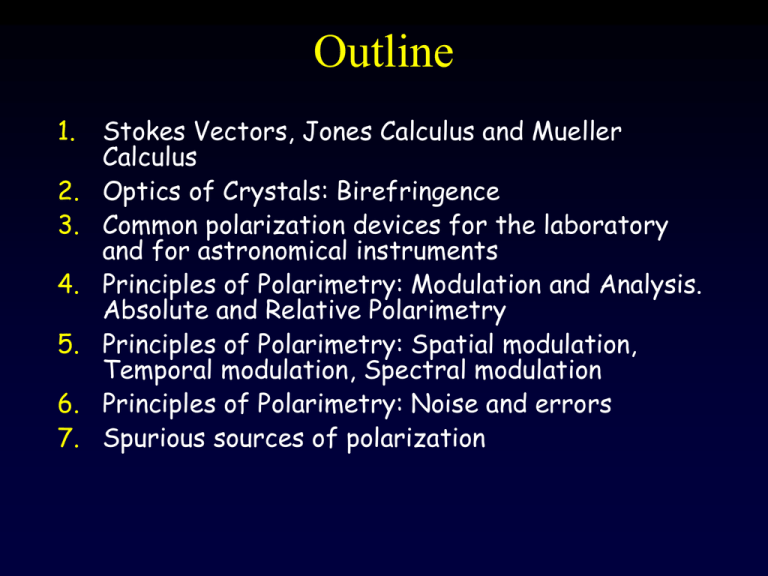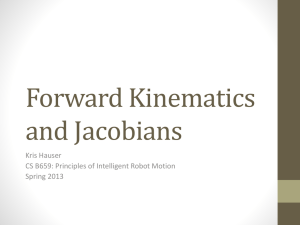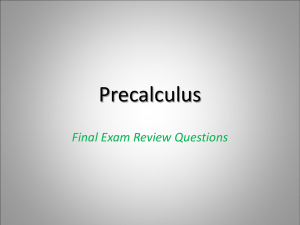Vector Magnetic Fields in Prominences
advertisement

Outline 1. 2. 3. 4. 5. 6. 7. Stokes Vectors, Jones Calculus and Mueller Calculus Optics of Crystals: Birefringence Common polarization devices for the laboratory and for astronomical instruments Principles of Polarimetry: Modulation and Analysis. Absolute and Relative Polarimetry Principles of Polarimetry: Spatial modulation, Temporal modulation, Spectral modulation Principles of Polarimetry: Noise and errors Spurious sources of polarization Stokes Vector, Jones Calculus, Mueller Calculus playing around with matrices A. López Ariste Assumptions: •A plane transverse electromagnetic wave •Quasi-monochromatic •Propagating in a well defined direction z E x Ax E A e i y y i ( kzt ) e E x Ax E A e i y y Jones Vector i ( kzt ) e E x Ax E A e i y y i ( kzt ) e Jones Vector: It is actually a complex vector with 3 free parameters It transforms under the Pauli matrices. It is a spinor E x a b E x Ex C E y c d E y Ey C a i 0,3 i i The Jones matrix of an optical device C a i 0,3 1 0 0 0 2 1 i i 0 1 1 0 1 0 1 1 0 0 i 3 i 0 In group theory: SL(2,C) E x Ax E A e i y y i ( kzt ) e From the quantum-mechanical point of view, the wave function cannot be measured directly. Observables are made of quadratic forms of the wave function: J EE J is a density matrix : The coherence matrix E x E x* E x E *y J * * E E E E y x y y Like Jones matrices, J also belongs to the SL(2,C) group, and can be decomposed in the basis of the Pauli matrices. J I 0 Q 1 U 2 V 3 I Q U V Is the Stokes Vector J I 0 Q 1 U 2 V 3 I Q I U V The Stokes vector is the quadractic form of a spinor. It is a bispinor, or also a 4vector I Tr ( J ) I Tr ( J ) I Q U V 0 0 2 1, 2,3 0 2 I Q U V 0 2 2 2 2 4-vectors live in a Minkowsky space with metric (+,-,-,-) The Minkowski space I Cone of (fully polarized) light I 2 Q2 U 2 V 2 Partially polarized light Fully polarized light I 2 Q2 U 2 V 2 V Q E x a b E x Ex C E E E c d y y y Ex J E x E y CEE C CJC Ey I Tr ( J ) Tr (CJC ) Tr (CC ) I MI M is the Mueller matrix of the transformation M Tr (CC ) M Tr (CC ) From group theory, the Mueller matrix belongs to a group of transformations which is the square of SL(2,C) SL(2, C ) SL(2, C ) Actually a subgroup of this general group called O+(3,1) or Lorentz group The cone of (fully polarized) light I Lorentz boost = de/polarizer, attenuators, dichroism V Q The cone of (fully polarized) light I 3-d rotation = retardance, optical rotation V Q Mueller Calculus • Any macroscopic optical device that transforms one input Stokes vector to an output Stokes vector can be written as a Mueller matrix • Lorentz group is a group under matrix multiplication: A sequence of optical devices has as Mueller matrix the product of the individual matrices Mueller Calculus: 3 basic operations • Absorption of one component • Retardance of one component respect to the other • Rotation of the reference system Mueller Calculus: 3 basic operations • Absorption of one component a 0 Ca 0 1 C 0 0 2 1 a 1 M 2 0 0 1 0 0 1 0 0 0 0 0 0 0 0 Mueller Calculus: 3 basic operations • Absorption of one component • Retardance of one component respect to the other 1 0 i i C 1 e 1 e 1 0 i 0 e 1 0 M 0 0 0 0 1 0 0 cos 0 sin 0 0 sin cos Mueller Calculus: 3 basic operations • Absorption of one component • Retardance of one component respect to the other • Rotation of the reference system cos C sin sin cos 0 sin 3 cos 0 1 0 cos 2 M 0 sin 2 0 0 0 sin 2 cos 2 0 0 0 0 1 Optics of Crystals: Birefringence A. López Ariste Chapter XIV, Born & Wolf Ellipsoïd Ellipsoïd Three types of crystals A spherical wavefront Three types of crystals Two apparent waves propagating at different speeds: •An ordinary wave, with a spherical wavefront propagating •at ordinary speed vo •An extraordinary wave with an elliptical wavefront, its speed Three types of crystals s z The ellipsoïd of D in uniaxial crystals De Do The two propagating waves are linearly polarized and orthogonal one to each other Typical birefringences •Quartz +0.009 •Calcite -0.172 •Rutile +0.287 •Lithium Niobate -0.085 Common polarization devices for the laboratory and for astronomical instruments A. López Ariste Linear Polarizer 0.5 0.5 0.5 0.5 M 0 0 0 0 0 . 5 0 .5 0 . 5 0 .5 M R( ) 0 0 0 0 0 0 0 0 0 0 0 0 0 0 cos 2 sin 2 1 0 0 1 cos 2 2 cos 2 sin 2 cos 2 R ( ) 0.5 0 0 sin 2 sin 2 cos 2 sin 2 2 0 0 0 0 0 0 0 0 0 Retarder 1 0 M 0 0 1 0 M R ( ) 0 0 0 0 1 0 0 cos 0 sin 0 0 1 0 0 cos 0 sin 0 0 sin cos 0 0 1 R ( ) ? sin cos Savart Plate Glan-Taylor Polarizer Glan-Taylor.jpg Glan-Thompson Polarizing Beam-Splitter Rochon Polarizing Beamsplitter Polaroid Dunn Solar Tower. New Mexico Typical birefringences •Quartz +0.009 •Calcite -0.172 •Rutile +0.287 •Lithium Niobate -0.085 Zero-order waveplates ne n0 d Multiple-order waveplates Waveplates Principles of Polarimetry Modulation Absolute and Relative Polarimetry A. López Ariste Measure # 1 : I + Q Measure # 2 : I - Q Subtraction: (M1 #–1M2 ) = Q # 2? How to switch from0.5 Measure to Measure Addition: MODULATION 0.5 (M1 + M2 ) = I Measure # 1 : I + Q Measure # 2 : I - Q Principle Polarimetry Subtraction: 0.5of(M1 – M2 ) = Q Everything should be the same EXCEPT for the sign Addition: 0.5 (M1 + M2 ) = I MODULATION M1 c S j 1, N 1 j S1 I S2 Q j S3 U Mn c S j 1, N n j j S4 V MODULATION M1 c S j 1, N 1 j S1 I S2 Q j S3 U Mn c S j 1, N n j j S4 V c 0 i 1 c i 2 , 3, 4 c i 1 MODULATION M1 c S j 1, N Mn 1 j M OI j O is the Modulation Matrix c S j 1, N n j j c 0 i 1 c i 2 , 3, 4 c i 1 MODULATION M1 I Q M2 I Q M3 I U M 4 I U M5 I V M 6 I V 1 1 0 0 1 1 0 0 1 0 1 0 O 1 0 1 0 1 0 0 1 1 0 0 1 Conceptually, it is the easiest thing Is it so instrumentally? Is it efficient respect to photon collection, noise and errors? Del Toro Iniesta & Collados (2000) Asensio Ramos & Collados (2008) MODULATION M OI 1 I O M DM i I ,Q ,U ,V D j 1, n 2 ij i I ,Q ,U ,V n Dij2 j 1, n Del Toro Iniesta & Collados (2000) Asensio Ramos & Collados (2008) MODULATION 1 I O M DM i I ,Q ,U ,V n Dij2 j 1, n I 1 i Q ,U ,V 2 i 1 MODULATION M1 I Q M2 I Q M3 I U M 4 I U M5 I V M 6 I V 1 1 0 0 1 1 0 0 1 0 1 0 O 1 0 1 0 1 0 0 1 1 0 0 1 I 1 Q ,U ,V 1 3 Design of a Polarimeter •Specify an efficient modulation scheme: The answer is constrained by our instrumental choices Absolute vs. Relative Polarimetry i I ,Q ,U ,V n Dij2 j 1, n I 1 i Q ,U ,V 2 i 1 Efficiency in Q,U and V limited by efficiency in I What limits efficiency in I? Absolute vs. Relative Polarimetry What limits efficiency in I? Measure # 1 : I + Q Measure # 2 : I - Q Principle of Polarimetry Subtraction: 0.5 (M1 – M2 ) = Q Everything should0.5 be the same EXCEPT Addition: (M1 + M2 ) = Ifor the sign Absolute vs. Relative Polarimetry What limits efficiency in I? Measure # 1 : I + Q Measure # 2 : I - Q Usual photometry of present astronomical detectors is around 10-3 Principle of Polarimetry Subtraction: 0.5 (M1 – M2 ) = Q Everything should0.5 be the same EXCEPT Addition: (M1 + M2 ) = Ifor the sign Absolute vs. Relative Polarimetry What limits efficiency in I? Usual photometry of present astronomical detectors is around 10-3 You cannot do polarimetry better than photometry Absolute vs. Relative Polarimetry What limits efficiency in I? Usual photometry of present astronomical detectors is around 10-3 You cannot do ABSOLUTE polarimetry better than photometry Absolute vs. Relative Polarimetry Q Q M 1 I Q I 1 1 I I Q Q M 2 I Q I 1 1 I I Q Q I 1 ( I )1 I ( I ) Q (2 I ) ( I ) Q 2 2 Q I 1 I I Absolute error : 10-3 I Relative error : 10-3 Q Absolute vs. Relative Polarimetry Q Q M 1 I Q I 1 1 Li 6708I I Q Q M 2 I Q I 1 1 I I Q Q I 1 ( I )1 I ( I ) Q (2 I ) ( I ) Q 2 2 Q I 1 I I Absolute error : 10-3 I Relative error : 10-3 Q D2 D1 D2 Phase de 45 deg Phase de 102 deg Design of a Polarimeter •Specify an efficient modulation scheme: The answer is constrained by our instrumental choices •Define a measurement that depends on relative polarimetry, if a good sensitivity is required Principles of Polarimetry Spatial modulation, Temporal modulation, Spectral modulation A. López Ariste Measure # 1 : I + Q Measure # 2 : I - Q Subtraction: (M1 #–1M2 ) = Q # 2? How to switch from0.5 Measure to Measure Addition: MODULATION 0.5 (M1 + M2 ) = I M1 I Q M2 I Q M3 I U M 4 I U M5 I V M 6 I V How to switch from Measure # 1 to Measure # n? Analyser: Calcite beamsplitter I Q M U V I Q I Q 0 0 I Q I Q 0 0 Analyser: Rotating Polariser 1 cos 2 sin 2 0 cos 2 sin 2 cos 2 2 cos 2 sin 2 sin 2 cos 2 sin 2 2 0 0 0 I I Q Q 0 0 0 I I Q cos 2 U sin 2 2 0 Q I cos 2 Q cos 2 U cos 2 sin 2 0 U I sin 2 Q sin 2 cos 2 U sin 2 2 0 V 0 2 I Q I Q 0 0 Analyser: Calcite beamsplitter 2 beams ≡2 images Spatial modulation Analyser: Rotating Polariser 2 angles ≡ 2 exposures Temporal modulation Modulator: I Q M Analyzer U V I I Q Q 0 0 What about U and V? Modulator: I I Q U M Modulator U Q V V I I Q V M Modulator U U V Q Modulator: I I Q U M Modulator U Q V V I I Q V M Modulator U U V Q I I U Q I U M An M Mod U A V B I I V Q I V M An M Mod U A V B Modulator: Rotating λ/4 0 1 0 cos 0 0 0 sin 0 I I 0 sin Q Q cos V sin 1 0 U U 0 cos V Q sin V cos 0 I V U 2 Q I I Q I M An M Mod U V V V A B The basic Polarimeter Modulator I Q U V I S1 S 2 S 3 Analyzer I I S1 S1 S2 S 3 I I S1 S1 S2 S 3 S1 Examples 2 Quarter-Waves + Calcite Beamsplitter QW1 QW2 Measure T1 0° 0° Q T2 22.5 ° 22.5 ° U T3 0° -45 ° V T4 0° 45 ° -V …. LCVR Calcite M O( wavelength) I Examples 1 2 Rotating Quarterwave plate + Calcite Beamsplitter Photelastic Modulators (PEM) + Linear Polariser S1 Q cos 2t U cos 2t sin 2t V sin 2t 2 S Q 1 0 2 S S 1 1 0 S 0 3 2 4 1 1 4 2 4 S S 2 V 1 S 3 4 1 U Spectral Modulation Chromatic waveplate: 0 1 0 cos ( ) 0 0 0 sin ( ) Followed by an analyzer f ( ) I 0 sin ( ) Q U 1 0 0 cos ( ) V 0 0 S1 Q cos ( ) Spectral Modulation Chromatic waveplate: 0 1 0 cos ( ) 0 0 0 sin ( ) Followed by an analyzer f ( ) I 0 sin ( ) Q U 1 0 0 cos ( ) V 0 0 S1 Q cos ( ) See Video from Frans Snik (Univ. Leiden) Principles of Polarimetry Noise and errors A. López Ariste Sensitivity vs. Accuracy SENSITIVITY: Smallest detectable polarization signal related to noise levels in Q/I, U/I, V/I. RELATIVE POLARIMETRY ACCURACY: The magnitude of detected polarization signal That can be quantified Parametrized by position of zero point for Q, U, V ABSOLUTE POLARIMETRY Sensitivity vs. Accuracy SENSITIVITY: Smallest detectable polarization signal related to noise levels in Q/I, U/I, V/I. RELATIVE POLARIMETRY 1 I O M DM Gaussian Noise (e.g. Photon Noise, Camera Shot Noise) i I ,Q ,U ,V n D j 1, n 2 ij Correcting some unknown errors Spatio-temporal modulation Detectin in different pixels Goal: to make the measurements symmetric respect to unknown errors in space and time I+V I-V Exposure 1 Spatio-temporal modulation Detectin in different pixels Goal: to make the measurements symmetric respect to unknown errors in space and time I+V I-V Detection at different times I-V Exposure 1 I+V Exposure 2 Spatio-temporal modulation I V 1 I V 2 I V 1 I V 2 V I : V 1 4 I V o I 2 I+V I-V I-V I+V Exposure 1 Exposure 2 Spatio-temporal modulation V I : I V 1 I V 2 I V 1 I V 2 V 1 4 I V o I Let’s make it more general I O I O2 I K O I O2 I I0 1 1 I o I 0 2 2 Cross-Talk I I Q I M An M Mod U V This is our polarimeter S1 S1 A B This is what comes from the outer universe Is this true? I Q U V Star I Q U V Star ? I Q U V Star 0 0 0.99 0.009 0 0 0.009 0.99 M 0 0 0.935 0.323 0 0 0.323 0.935 I Q U V Star CrossTalk I Q M Telescope U V Star I Q U V Star 0 0 0.99 0.009 0 0 0.009 0.99 M 0 0 0.935 0.323 0 0 0.323 0.935 Solutions to Crosstalk 1. Avoid it: Mirrors with spherical symmetry (M1,M2) introduce no polarization Cassegrain-focus are good places for polarimeters THEMIS, CFHT-Espadons, AAT-Sempol,TBL-Narval,HARPS-Pol,… 2. Measure it Given M find its inverse and apply it to the measurements Telescope It may be dependent on time and wavelength It forces you to observe the full Stokes vector Dunn Solar Tower. New Mexico Solutions to Crosstalk 3. Compensate it Several procedures: • Introduce elements that compensate the instrumental polarization • Measure the Stokes vector that carries the information • Project the Stokes vector into the Eigenvector of the matrix








